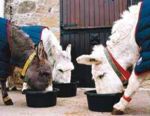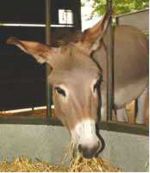Diet and Management (Older) - Donkey
Jump to navigation
Jump to search
Diet and the older donkey

Below are some recommendations of husbandry methods that are of specific use in the geriatric animal having problems maintaining condition:
- Aged animals should be fed separately from more boisterous individuals or those with a decreased calorie requirement
- Individuals with dental disease or chronic low-grade pain associated with conditions such as osteoarthritis often need special arrangements to feed satisfactorily
- Small alterations in husbandry which include raising the height of feed buckets and grating tasty treats such as carrots and apples will encourage the animal to eat and look forward to feed times
- Time to complete a feed can become an increasing issue for the older donkey with osteoarthritis or dental problems; ensure there is sufficient space and time for the donkey to eat at its own pace
- Throughout the year, supplementary feeds can include softened grass or high fibre cubes, soaked sugar beet fibre, short chopped alfalfa/hay/straw/mixes and forage mixes
- Perhaps the most important feature of feeding the older donkey is to avoid sudden changes in diet
- Older donkeys will benefit from a mineral and vitamin supplement such as TopSpec Comprehensive Feed Balancer
Due to dryness and length of stem, summer grazing, long stem hay and straw may not be effectively masticated and may cause choking or impaction in individuals with extensive dental disorders.
Some aged animals still manage to retain a lot of body condition despite other geriatric conditions. Whereas weight loss is obviously desirable in clinical cases of osteoarthritis and laminitis, extreme care should be taken to avoid tipping the subject over into hyperlipaemia.
Suggested routine care and management of the 20+ year old donkey

- Regularly monitor condition and weight objectively. Record weight or girth measurements and condition score
- Avoid obesity
- Feed according to weight, dentition, season, laminitic predispositon and the individual response to intake. Adlib or small and frequent feeds rather than a single daily ‘feast’ are advisable. Many aged donkeys spend most of their day getting through these feeds but, surprisingly, manage to thrive quite well as long as they are given the opportunity to eat in their own time
- Regular, preferably six-monthly, dental examinations. See Donkey Dental Care for Vets and Equine Dental Technicians factsheet
- Tetanus vaccination
- Regular faecal worm egg counts (at least four times a year)
- Elderly donkeys can be more susceptible to suffering from heavy lice infestations, regular checking and treatment should be provided
- Routine, regular hoof trimming at intervals of four to ten weeks depending on the individual’s hoof status
- Provide well fitting rugs (poorly fitting ones are more of a liability than none at all)if necessary. Rugs may help to prevent excessive weight loss over the winter in thin, elderly donkeys.
- Consider obtaining reference values for haematology and biochemistry whilst in good health
- Provide adequate winter and summer shelter and satisfactory underfoot conditions
- Provide flat paddocks for chronically lame individuals and consider the use of NSAIDs to increase quality of life
- Encourage exercise. Walking in-hand gives the individual an interest in life as well as often much needed exercise
- Feed and water old donkeys separately and at an appropriate height
- Encourage ‘hands-on’ daily care, grooming and hoof-picking. This handling in its own right helps reduce stress when veterinary treatment becomes necessary
- Monitor chronic pain and quality of life on a regular basis. See Donkey Quality of Life Assessment factsheet
References
- Sprayson, T. (2008) The care of the geriatric donkey In Svendsen, E.D., Duncan, J. and Hadrill, D. (2008) The Professional Handbook of the Donkey, 4th edition, Whittet Books, Chapter 13
|
|
This section was sponsored and content provided by THE DONKEY SANCTUARY |
|---|